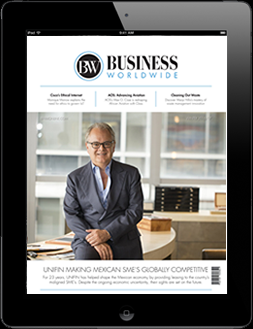Are our work environments impacting our moods and behaviour? Mexico City based SpAce Arquitectura have researched behavioural and wellbeing links to incorporate neuro architecture into corporate spaces. Juan Carlos Baumgartner, Founder and CEO gives us a fascinating insight into this concept.
Borne out of a passion for design and architecture, SpAce Arquitectura, an architectural and interior design organisation in Chicago, USA was founded in 1999. Nearly twenty-three years later, this award-winning enterprise, now operating out of Mexico City, is recognised as a forerunner in the Latin American interior design space, achieving success with projects spanning more than 20 countries.
Research shows that our environment can have fundamental effects on our health and behaviour, and with an estimated 80 per cent of our time spent indoors – our personal living spaces, educational and corporate environments, healthcare establishments spaces and commercial outlets – SpAce Arquitectura recognises that the build environment has the capacity to transform people’s lives in meaningful ways. It sees beyond the traditional focus on trending fabrics, colours, tones and textures and uses technology and expertise to incorporate these into a revolutionary concept known as neuro architecture.
Jean Carlos Baumgartner, founder and CEO of SpAce Arquitectura tells us more about the changing power of architecture, the strategy behind his unique organisation and how it plays a fundamental role in improving the lives of many across the world.
How does SpAce Arquitectura sets itself apart from its competitors?
Firstly, we spend time evaluating the emotional profiles of our customers. It’s important to us to be able to firmly establish the type of experience they wish their clients to resonate with, the psychology of decision making.
In addition, neuroscience and the impact that buildings have on our brain, our behaviour or our emotional wellbeing, is always foremost in our design approach.
This is closely related to your company ethos and slogan ‘Design for Happiness.’ Can you elaborate further on this link?
Shaping our physical workspaces ultimately modifies our culture. Far too often we hear the phrase, “you’re here to work, not to socialise.’ However, studies show that this type of corporate approach has negative consequences on our health and wellbeing. Emotional solutions need to be functional, relevant and appropriate to all user needs, therefore we should be designing light, airy, spacious work environments which encourage interaction ultimately leads to greater participation, engagement and productivity.
Evidence based design delivers on mental and physical wellbeing as well as having ethical sustainability benefits. Architects have a responsibility to design buildings which focus on careful consideration on how their work can change lives and communities. ‘Design for Happiness’ is reflected in all SpAce Arquitectura projects.
So incorporating research from neuroscience into architecture?
Yes, this is a concept we call Neuro Architecture. Whilst architecture has been influenced by new construction techniques through advanced technology, 3-D printing for example, it has become increasingly evident that the practice of teaching architecture must evolve to keep pace with the demands of society as well as resolving new challenges.
One of the greatest challenges arises from advancements in neuroscience and the role of architecture in understanding the correlation between physical spaces and human behaviour. For instance, we know that natural light influences work performance but does it help students to learn more effectively? Does a soft floor surface generate a space to calm pre-school children? Geometry, shape and flow of movement may improve sensory perception. The addition of plants and foliage can reduce stress and improve concentration as well as providing a lovely natural vibe.
Could you give us any case studies where SpAce has worked with corporates to enhance their brand experience?
We’re delighted to have been approached to work with many global corporates. One which stands out is being commissioned to design a showroom for Calvin Klein’s Mexican Headquarters. We wanted our design to be sleek, sophisticated and modern, yet remaining warm and simple and in keeping with the brand’s luxury image and heritage. We used natural materials, neutral colours, straight lines, rustic detailing and custom-made lighting to create a warm, homely environment reminiscent of a New York loft space. We also worked closely with Calvin Klein with the corporate roll out of our prototype scene, educating designers about the value of emotional design in Latin American markets and how uniquely designed retail environments contributes to higher sales.
We’ve worked with an extensive client base across Mexico, notably in the education environment where we’ve created safe play areas for nurseries with an emphasis on fun, vibrant educational play, as well as modern study areas for schools and colleges. We’ve also carried out major refurbishments in the hospital and healthcare sector where we believe focused attention on the emotional side of design elements, neuro architecture, plays an important role in contributing to the wellbeing of patients and quicker discharge times.
Regardless of whether we’re designing a small space, large building, campus, shop our housing complex, our philosophy is always the same – to seek sustainable solutions which respect the environment and improve habitats.
You also mentioned benefits associated with sustainability, an integral feature inbuilt within your design processes. Could you tell us about the ‘Green Scale’ methodology implemented into each of your projects?
The inclusion of wellness and sustainability elements is important to us at SpAce, as we have a responsibility to both our clients and neighbourhoods to be economical with resources as well as adopting environmentally friendly practices. We are proud of our achievements in this field, adding recognition in sustainability to our increasing portfolio of awards.
Our ‘Green Scale’ methodology reflects the level to which each project has the potential to be sustainable. This consists of three levels:
Light Green – Project includes energy saving techniques and a rational use of resources.
Medium Green – In addition to the measures adopted under ‘Light Green’ this category also includes extra eco specifications and technology investments to increase energy savings.
Dark Green – Fulfilling projects with LEED (international standard for the design, construction and maintenance of environmentally sustainable buildings and infrastructure) certification. A high level of ecological awareness and commitment.
SpAce Arquitectura are indeed a visionary enterprise, constantly working to educate architects via university research on the benefits of neuro architecture for our homes, education and workplaces and using modern technological techniques to incorporate emotionally designed concepts into community environments. Further information, images of projects the organisation has carried out throughout Mexico and beyond, together with up to the date industry news, services, and contact details, can be found on the company website: – https://spacemex.com
















